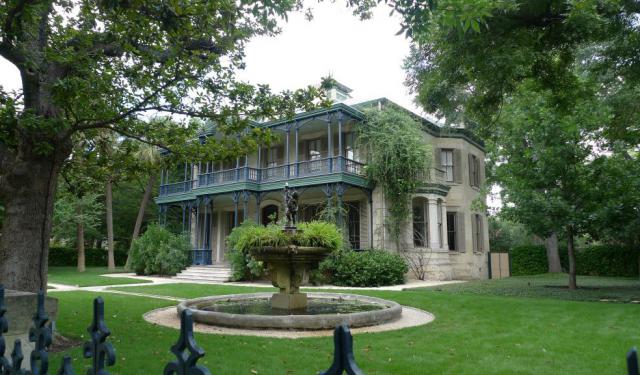
Alamo, San Antonio (must see)
The Alamo, originally known as Misión San Antonio de Valero, is a historic Spanish mission and fortress in San Antonio. Founded in the 18th century by Roman Catholic missionaries, the mission was intended to convert local Indigenous populations to Christianity. Secularized in 1793, it was later abandoned and repurposed as a military fortress by the Second Flying Company of San Carlos de Parras, who gave it the name "Alamo," likely referencing the nearby poplar trees.
The site gained iconic status as the location of the 1836 Battle of the Alamo during the Texas Revolution. Here, a small group of Texian defenders, including legendary figures James Bowie and Davy Crockett, held out against Mexican forces led by General Santa Anna before being overwhelmed on March 6, 1836. This pivotal event became a symbol of Texian resistance and sacrifice. After the Mexican Army's retreat, much of the Alamo was destroyed.
The Alamo evolved from a military garrison to a U.S. Army depot before falling into neglect. Preservation efforts began in 1905 with the Daughters of the Republic of Texas, leading to state ownership. In 2015, the Texas General Land Office took over, ensuring its protection as a cultural landmark. That year, the Alamo and nearby missions became a UNESCO World Heritage Site.
Today, the Alamo is one of the most visited historic sites in the United States, drawing over four million visitors annually. The site features the iconic chapel and the Long Barracks, which house a museum showcasing artifacts, weapons, and paintings from the Texas Revolution. Visitors can also view a detailed diorama recreating the compound as it appeared in 1836, along with the Wall of History mural, which chronicles the site's evolution from its mission days to modern times.
The site gained iconic status as the location of the 1836 Battle of the Alamo during the Texas Revolution. Here, a small group of Texian defenders, including legendary figures James Bowie and Davy Crockett, held out against Mexican forces led by General Santa Anna before being overwhelmed on March 6, 1836. This pivotal event became a symbol of Texian resistance and sacrifice. After the Mexican Army's retreat, much of the Alamo was destroyed.
The Alamo evolved from a military garrison to a U.S. Army depot before falling into neglect. Preservation efforts began in 1905 with the Daughters of the Republic of Texas, leading to state ownership. In 2015, the Texas General Land Office took over, ensuring its protection as a cultural landmark. That year, the Alamo and nearby missions became a UNESCO World Heritage Site.
Today, the Alamo is one of the most visited historic sites in the United States, drawing over four million visitors annually. The site features the iconic chapel and the Long Barracks, which house a museum showcasing artifacts, weapons, and paintings from the Texas Revolution. Visitors can also view a detailed diorama recreating the compound as it appeared in 1836, along with the Wall of History mural, which chronicles the site's evolution from its mission days to modern times.
Want to visit this sight? Check out these Self-Guided Walking Tours in San Antonio. Alternatively, you can download the mobile app "GPSmyCity: Walks in 1K+ Cities" from Apple App Store or Google Play Store. The app turns your mobile device to a personal tour guide and it works offline, so no data plan is needed when traveling abroad.
Alamo on Map






Sight Name: Alamo
Sight Location: San Antonio, USA (See walking tours in San Antonio)
Sight Type: Religious
Guide(s) Containing This Sight:
Sight Location: San Antonio, USA (See walking tours in San Antonio)
Sight Type: Religious
Guide(s) Containing This Sight:
Walking Tours in San Antonio, Texas
Create Your Own Walk in San Antonio
Creating your own self-guided walk in San Antonio is easy and fun. Choose the city attractions that you want to see and a walk route map will be created just for you. You can even set your hotel as the start point of the walk.
River Walk Tour
The San Antonio River Walk (also known as Paseo del Río or simply The River Walk) is a network of walkways along the banks of the San Antonio River, one story beneath the streets of the city. A successful special-case pedestrian street, this walk winds and loops under bridges as two parallel sidewalks lined with restaurants and shops, connecting major tourist draws and attractions that add to its... view more
Tour Duration: 1 Hour(s)
Travel Distance: 1.9 Km or 1.2 Miles
Tour Duration: 1 Hour(s)
Travel Distance: 1.9 Km or 1.2 Miles
San Antonio Introduction Walking Tour
San Antonio, one of Texas' major cities, boasts rich colonial heritage. The city was named by a 1691 Spanish expedition for Saint Anthony of Padua, whose feast day is June 13. At the time of European encounter, the area near the San Antonio River Valley was inhabited by Payaya Indians who called it Yanaguana, the "refreshing waters".
In 1709, Spanish Father Antonio de Olivares... view more
Tour Duration: 2 Hour(s)
Travel Distance: 3.3 Km or 2.1 Miles
In 1709, Spanish Father Antonio de Olivares... view more
Tour Duration: 2 Hour(s)
Travel Distance: 3.3 Km or 2.1 Miles
King William Historical District Tour
San Antonio’s first “suburb” and the very first historical district in Texas, revitalized during the 1960s, the King William District encompasses 25 blocks south of downtown and east of the San Antonio River.
Back in the late 1800s, it was the most elegant residential area in the city. Settled by German immigrants, the neighborhood was named after Kaiser Wilhelm of Prussia and... view more
Tour Duration: 1 Hour(s)
Travel Distance: 1.1 Km or 0.7 Miles
Back in the late 1800s, it was the most elegant residential area in the city. Settled by German immigrants, the neighborhood was named after Kaiser Wilhelm of Prussia and... view more
Tour Duration: 1 Hour(s)
Travel Distance: 1.1 Km or 0.7 Miles



